稀有金属 2013,37(05),720-725
Fe含量对快淬SmFe合金结构的影响
卢硕 于敦波 李扩社 靳金玲 罗阳 李红卫
北京有色金属研究总院稀土材料国家工程中心,有研稀土新材料股份有限公司
摘 要:
在轮速为40 m·s-1快淬制备不同Fe含量的亚稳态快淬SmFe x (x=7.5, 8.0, 8.5, 9.0, 9.5, 10.0, 10.5, 11.0, 12.0, 13.0) 合金, 经过800℃退火处理60 min, 采用XRD分析了快淬SmFe x合金退火前后的相组成和晶体结构, 并结合Rietveld结构精修方法分析了TbCu7型SmFe9相的晶体结构。结果表明:快淬SmFe x合金在化学计量数SmFe x (x=7.58.0) 时, 形成Th2Zn17型Sm2Fe17和少量的SmFe2;随着Fe含量增加, 在x=8.513.0时, 由平衡相转变成亚稳TbCu7型SmFe9相, α-Fe含量逐渐增多。随着Fe含量增加, SmFe合金的晶格常数a不断减小, 而晶格常数c, c/a不断增大。在TbCu7型SmFe9相中Fe原子分别位于2e, 3g, 6l晶位, Sm原子自由占据1a晶位。2e晶位哑铃状Fe-Fe原子对的的占位趋于无序。退火后SmFe x合金在化学计量数x=8.5, 9.0时, 由亚稳相TbCu7型SmFe9转变为平衡Th2Zn17型Sm2Fe17相;在化学计量数SmFe x (x=9.513.0) 时, 保持TbCu7型SmFe9不变。退火使2e晶位哑铃状Fe-Fe原子对有序排列, Sm原子在1a晶位的占位率提高, 晶体结构由TbCu7型结构转变成Th2Zn17型结构, 但Fe含量超过一定值后, 无法继续这种转变。退火SmFe x合金晶体结构的晶胞参数变化规律与淬火态相同, 退火SmFe合金中α-Fe含量增多。
关键词:
快淬;SmFe合金;退火;晶体结构;晶胞参数;
中图分类号: TG131
作者简介:卢硕 (1986-) , 女, 河北保定人, 硕士;研究方向:稀土磁性材料;李扩社, E-mail:yyxt_liksh@163.com;
收稿日期:2013-04-08
基金:国家科技部“863”计划项目 (2011AA03A402) 资助;
Effects of Fe Content on Structure of Rapidly Quenched and Annealed Sm-Fe Alloys
Lu Shuo Yu Dunbo Li Kuoshe Jin Jinling Luo Yang Yan Wenlong Xie Jiajun Li Hongwei
Grirem Advanced Materials Co. , Ltd.;National Engineering Research Center for Rare Earth Materials, General Research Institute for Nonferrous Metals
Abstract:
Metastable SmFe x ( x =7. 5, 8. 0, 8. 5, 9. 0, 9. 5, 10. 0, 10. 5, 11. 0, 12. 0, 13. 0) alloys were prepared by rapid quenching and the phases and crystal structure were investigated in the as-quenched state and after annealing at 800 ℃ for 60 min by X-ray diffraction ( XRD) . Rietveld analysis was applied to study the crystal structure of SmFe9phase of TbCu7-type. The results showed that in stoichiometric SmFe x for x = 7. 5 ~ 8. 0, Th2Zn17-type Sm2Fe17 phases and a bit amount of SmFe2 were formed, TbCu7-type SmFe9phase rather than Th2Zn17-type structure was obtained by increasing the proportion of Fe ( x = 8. 5 ~ 13. 0) , and the content of α-Fe increased. Lattice parameters a decreased, but lattice parameters c and axial ratio c / a increased with the increase of Fe content. Sm was freely located in 1a position, Fe atoms in 2e site, 3g site, 6l site in TbCu7-type SmFe9 phases and dunbbell pairs of Fe-Fe randomly occupied 2e site. By annealing SmFe x alloys at x = 8. 5, 9. 0, Th2Zn17-type Sm2Fe17 phase was obtained from TbCu7-type structure, and at x = 9. 5 ~ 13. 0, TbCu7-type SmFe9 phase remained. Fe atoms at 2e site occupied an ordered arrangement, Sm atoms occupying ratio increased after annealing. Th2Zn17-type structures were transformed from TbCu7-type structure in annealed SmFe x alloys, but this transformation was prohibited when x increased to a certain content. Variation of lattice parameters of annealed Sm-Fe alloys was the same as the quenched, but α-Fe increased after annealing.
Keyword:
rapid quenching; Sm-Fe alloys; annealing; crystal structure; cell parameters;
Received: 2013-04-08
稀土过渡族化合物的磁性能取决于相的本征特征和微观组织[1,2]。自从1990年Coey等[3]发现Th2Zn17型Sm2Fe17Nx型化合物以来, 因其高居里温度 (476℃, 高出Nd2Fe14B将近160℃) , 良好的热稳定性和耐腐蚀性能等优点, 成为近年来研究的热点。1991年Katter等[4]研究表明, 利用快淬法制备Tb Cu7型Sm10Fe90Nx合金的性能与Sm2Fe17Nx化合物相似。渗氮后, 通过改善Fe-Fe原子对之间键长和Sm原子的有序排布能显著提高Sm Fe N合金的居里温度至750~900℃[5]。
Tb Cu7型结构的Sm Fe9为亚稳相, 通常采用快淬法[6]和机械合金化法制备[7]。Terrsiak等[8]利用机械合金化法制备的Sm Fe合金粉, 在600~750℃退火形成Tb Cu7型Sm Fe9, 在800~900℃退火则形成Th2Zn17型Sm2Fe17。为了抑制杂相的生成, 提高Sm Fe合金的磁性能, 通常在Sm Fe9合金中添加元素[9,10,11] (如Zr, Si, Ga等) 替代Sm或Fe原子位置, 改善其晶体结构, 提高化合物的磁性能。研究表明[12], Fe含量的变化对Sm Fe合金的相组成和晶体结构具有显著影响。然而, Fe过量或不足对Sm Fe合金中的晶体结构影响的研究很少, 目前基本上都是采用过量添加Sm10%~30%得到正成分的Tu Cu7型Sm Fe9合金, 并没有深入研究不同Fe配比的Sm Fe合金相组成和晶体结构[13,14]。因此, 本研究利用Rietveld结构精修的方法对快淬Sm Fe合金退火前后相组成和含量、晶胞参数、原子占位等情况进行分析, 为Sm Fe合金结构和成分的控制提供依据。
1 实验
以工业纯铁和纯度为99.9%的稀土Sm为原料, 在氩气气氛保护下轮速为40 m·s-1时[15]进行快淬制备合金薄带。将快淬制备的合金薄带在800℃氩气气氛中热处理60 min。
用理学Smartlab型X射线衍射仪对合金样品进行相组成和晶体结构分析。XRD测试参数为:采用步进扫描、Co靶Kα射线、石墨单色器、管压为40 k V、管电流为200 m A、扫描角度2θ=20°~110°、扫描速度为4 (°) ·min-1、步长为0.02°。获得的XRD图谱用理学自带软件PDXL2进行Rietveld法结构精修。
2 结果与讨论
2.1 快淬Sm Fe合金的晶体结构
图1是快淬轮速为40 m·s-1时, Sm Fex合金的XRD图谱。从图1可以看出在快淬Sm Fe合金中, 当x=7.5~8.0时, Sm Fex合金的相结构是菱方的Th2Zn17型Sm2Fe17和少量的立方Mg Cu2型Sm Fe2;当x=8.0~8.5时, Fe对Sm的有序取代被打破[2], 观察到相结构由有序的菱方的Th2Zn17型Sm2Fe17向无序的六方的Tb Cu7型Sm Fe9转变。随着Fe含量的增加 (x=9~13) 时, 相组成为六方的Tb Cu7型Sm Fe9和少量的α-Fe。随着配料中Fe含量的增多, α-Fe逐渐增加。
在x=7.5~8.0时, 快淬制备的Sm Fex合金的晶胞参数要比平衡相的Sm2Fe17 (a=0.4940 nm, c=0.4180 nm) 略小, 如表1所示。这主要是由于快淬凝固, 晶体结构中的晶格中存在一定的空位, 使晶格参数变小。利用Rietveld精修Sm Fe8合金, 原子的占位情况如表2所示, 其中原子占位率小于1, 而平衡相Th2Zn17型Sm2Fe17超结构的原子占位率都为1。除了形成主相Th2Zn17型Sm2Fe17外, 还有少量的Sm Fe2, 也证实了这一点。Sm2Fe17是母合金液冷却通过包晶反应形成, 随着Fe含量的增加, Sm Fe2越来越不容易形核长大而逐渐消失。
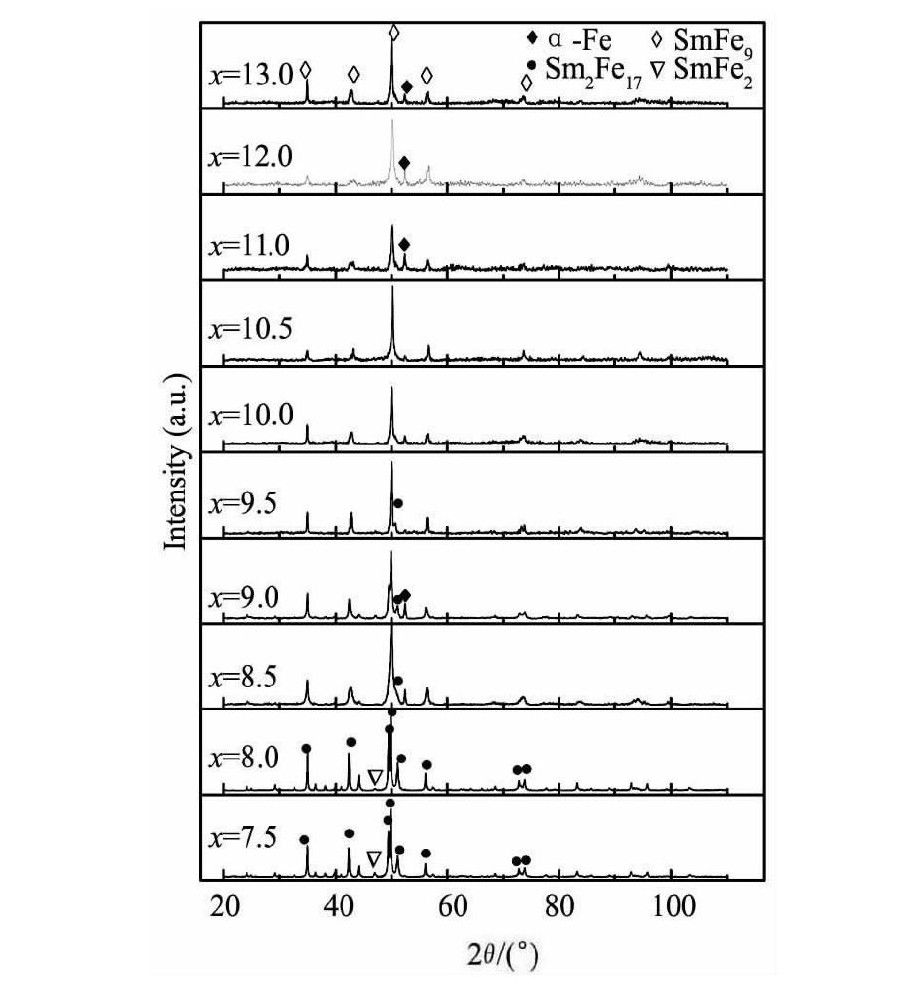
图1 快淬Sm Fex合金 (x=7.5~13.0) XRD图谱Fig.1XRD patterns of rapidly quenched Sm Fex (x=7.5~13.0) alloys (v=40 m·s-1)
Th2Zn17型Sm2Fe17和Tb Cu7型Sm Fe9是由Ca Cu5结构中不同量的RE原子被Fe-Fe哑铃状原子对取代而得到。实际的晶体结构取决于原子半径和合金的成分, 由于Sm Fe9合金在快淬制备方法中不存在平衡态[4]。Tb Cu7型结构不同于Buschow和Van Der Goot[16]提出的Tb Cu7型结构, 在P6/mmm空间群中2c (1/2, 1/20) 晶位被6l (x, 2x, 0) 晶位替代, 其占位率为1/3。在修正后的Tb Cu7型结构中, Sm原子位于1a位, Fe原子分别占2e, 3g, 6l位。在x=9~13时, 母合金液快速凝固, 原子的长程有序被破坏, 哑铃状Fe-Fe原子自由取代Sm原子, 形成Tb Cu7型Sm Fe9。但是随着Fe含量的增加, Sm原子被取代作用越来越明显, 在x=10.5时, 全部形成Tb Cu7型Sm Fe9。随着Fe含量继续增加, Fe原子对Sm原子的取代已经达到饱和, 伴随着少量的α-Fe形成, 随着Fe配比的增加而逐渐增加。对Sm Fe11合金进行Rietveld结构精修, 其原子占位情况表3所示。从表中可以看出Sm原子的占位率为0.465, 这远低于理想Tb Cu7结构的占位率 (0.667) , 随着Fe含量的增加, Sm的占位率并不会继续降低, 这种取代已经达到饱和。
表1 快淬Sm Fex合金 (v=40 m·s-1) 的晶体结构、晶格常数、晶胞体积和轴比c/a值Table 1 Structure, crystal symmetry, lattice parameters, unit cell volume V and c/a ratio of rapidly quenched Sm-Fe alloys (v=40 m·s-1) 下载原图

表1 快淬Sm Fex合金 (v=40 m·s-1) 的晶体结构、晶格常数、晶胞体积和轴比c/a值Table 1 Structure, crystal symmetry, lattice parameters, unit cell volume V and c/a ratio of rapidly quenched Sm-Fe alloys (v=40 m·s-1)
表2 快淬Sm Fe8合金Sm2Fe17的原子占位Table 2Atom site of Sm2Fe17phase in rapidly quenched Sm Fe8alloys 下载原图
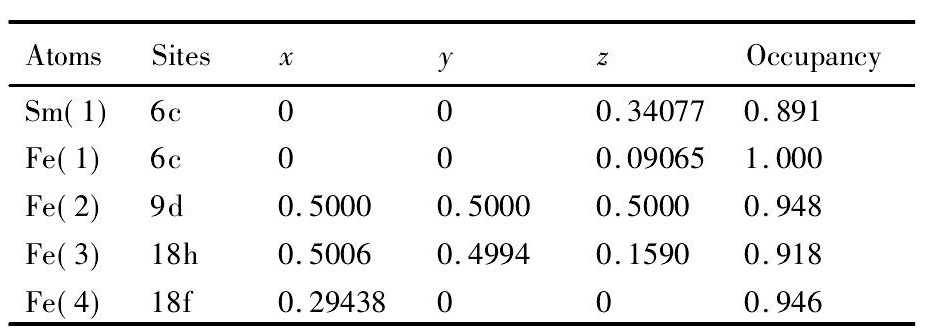
表2 快淬Sm Fe8合金Sm2Fe17的原子占位Table 2Atom site of Sm2Fe17phase in rapidly quenched Sm Fe8alloys
表3 快淬Sm Fe11合金Sm Fe9的原子占位Table 3Atom site of Sm Fe9phase in rapidly quenched Sm Fe11alloys 下载原图

表3 快淬Sm Fe11合金Sm Fe9的原子占位Table 3Atom site of Sm Fe9phase in rapidly quenched Sm Fe11alloys
利用Th2Zn17型Sm2Fe17和Tb Cu7型Sm Fe9晶胞参数的转换关系, 将Th2Zn17结构转变成Tb Cu7型结构, 如表1所示。从表1中可以看出, 随着Fe含量的增加, a值逐渐较小, c值逐渐增加, c/a值逐渐增加, 而晶胞体积无显著变化。Fe含量增加, 快淬Sm Fex合金中, Sm原子被Fe-Fe哑铃状原子对自由取代, 使a降低, c增加, 且这一取代位置向无序相转变。从图2可知, 在Sm Fex合金由Th2Zn17型Sm2Fe17转变为Tb Cu7型Sm Fe9时, 轴比c/a值发生显著变化。
2.2 退火后Sm Fe合金的晶体结构
图3为800℃退火60 min的Sm Fe合金的XRD图谱。从图3中可以看出在x=7.5~9.0时, Sm Fex合金的主相是Th2Zn17型Sm2Fe17, 退火使原子排列向长程有序转变, 使得Tb Cu7型Sm Fe9向Th2Zn17型Sm2Fe17转化。在x=9.5~11.0时, 退火后的主相仍然是Tb Cu7型Sm Fe9, 快淬Sm Fex合金中Sm原子的占位率为0.465, 过低的Sm含量不能使原子排列长程有序, 继续保持Tb Cu7型Sm Fe9不变。

图2 快淬Sm Fex合金的晶格常数和轴比c/a值Fig.2Lattice parameters a and c, and c/a ratio of rapidly quenched Sm Fexalloys (v=40 m·s-1)
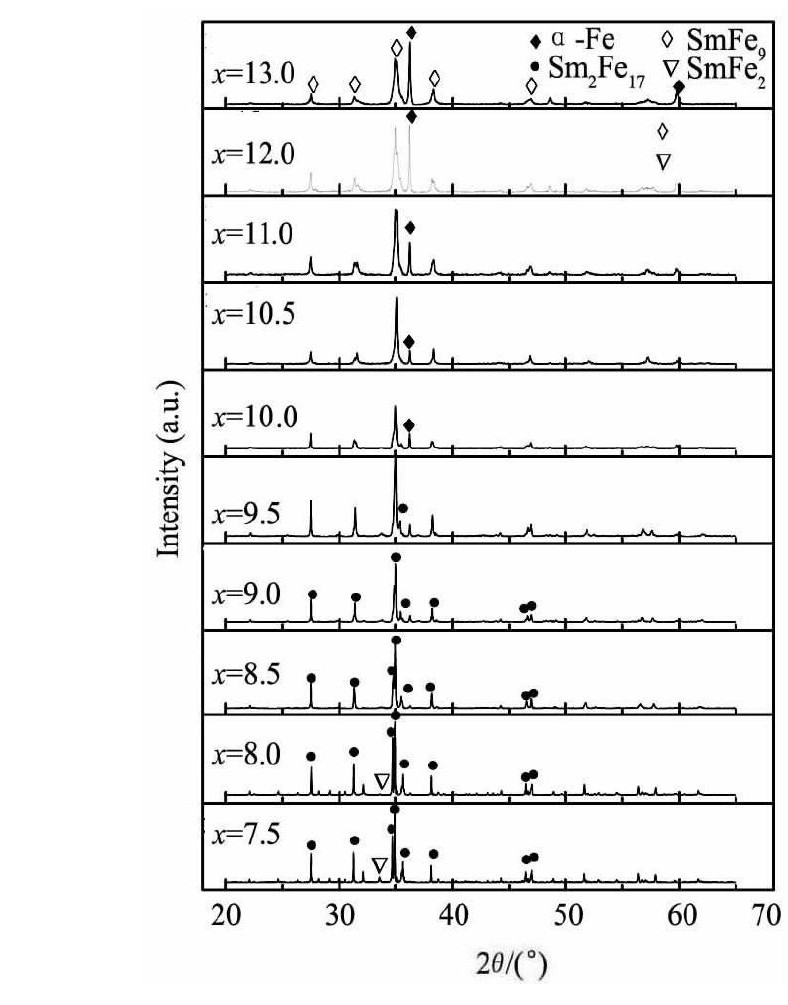
图3 退火后Sm Fex合金的XRD图谱Fig.3 XRD patterns of annealed Sm Fexalloys at TA=800℃
计算退火Sm Fex合金的晶胞参数如表4所示。在表4中可以看出, 随着Fe含量的增加, a值逐渐较小, c值逐渐增加, c/a值逐渐增加, 而晶胞体积无显著变化。这与快淬Sm Fex合金的变化规律相同。根据图4可以看出在x=7.5~8.0时, 轴比c/a值缓慢增加, 在x=8.0~8.5时, 迅速变化, 这可能是由于快淬态Sm Fe8.5合金主要由Tb Cu7型Sm Fe9组成, 而在退火时转变成Th2Zn17型Sm2Fe17, 使其轴比c/a值变大。比较表1和表4可以看出退火后Sm Fex合金的晶胞参数变大, 这可能是是退火使合金中原子排列从高能量向稳定态转变[17]。
表4 退火后Sm Fex合金的晶体结构、晶格常数、晶胞体积和c/a值Table 4 Structure, lattice parameters, unit cell volume V and axial c/a ratio of annealed Sm Fexalloys at TA=800℃ 下载原图
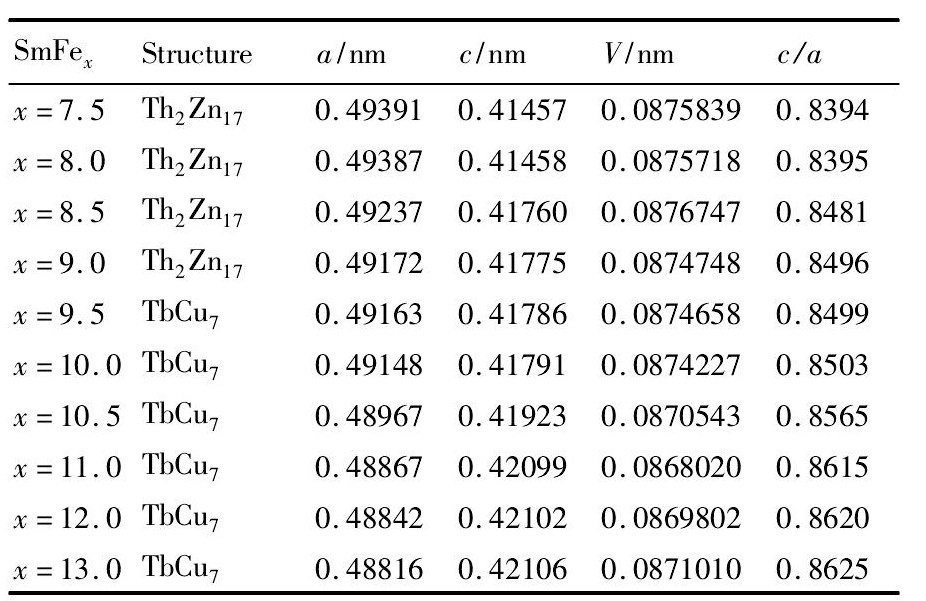
表4 退火后Sm Fex合金的晶体结构、晶格常数、晶胞体积和c/a值Table 4 Structure, lattice parameters, unit cell volume V and axial c/a ratio of annealed Sm Fexalloys at TA=800℃
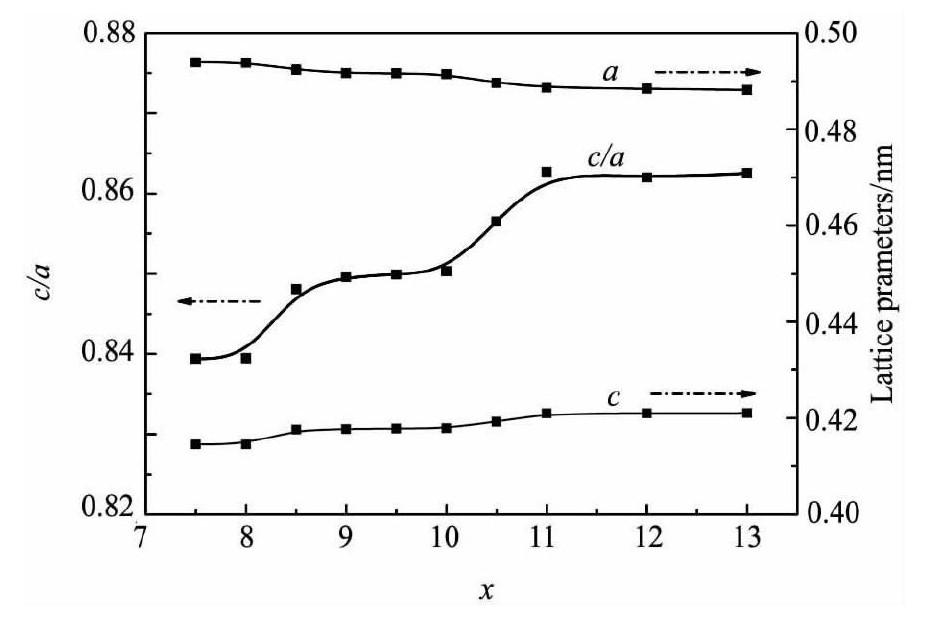
图4 快淬Sm Fex合金退火后的晶格常数和轴比c/a值Fig.4Lattice parameters, and axial ratio c/a of annealed Sm-Fe alloys at TA=800℃
在x=7.5~8.0时, 少量的Sm Fe2继续存在。这主要是由于在此退火温度下, Sm Fe2是稳定相, 即使Fe, Sm原子的配比大于7.5, 退火不能补偿Th2Zn17型Sm2Fe17晶体结构中的空位, 但是使晶体结构更加均匀化。退火后Sm Fe8合金的原子占位如表5所示, 和快淬Sm Fe8合金相比, 原子的占位率基本没有变化。在x=8.5~9.0时, 由于淬态Sm Fex合金中Sm原子的占位率比较高, Sm, Fe原子长程趋于有序排列, 故Tb Cu7型Sm Fe9向Th2Zn17型Sm2Fe17转化。
表5 退火后Sm Fe8合金Sm2Fe17的原子占位Table 5 Atom site of Sm2Fe17phase in annealed Sm Fe8alloys 下载原图
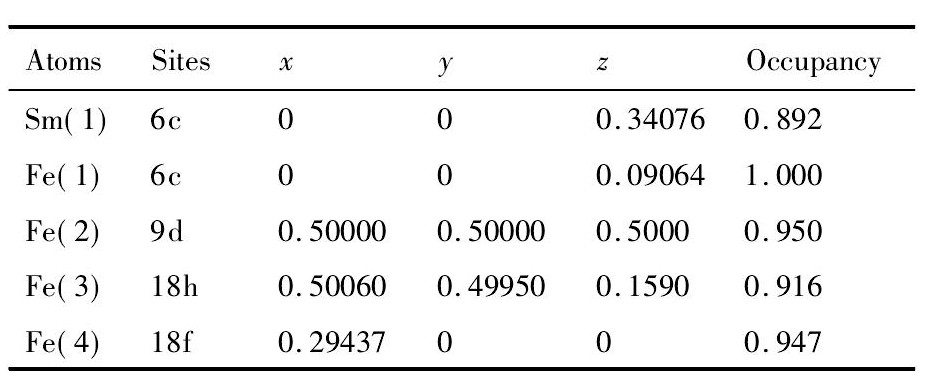
表5 退火后Sm Fe8合金Sm2Fe17的原子占位Table 5 Atom site of Sm2Fe17phase in annealed Sm Fe8alloys
在x=9.5~13.0时, 由于Fe含量增加, 退火对原子排列方式的影响不足以改变其晶体结构, Sm Fex合金继续保持Tb Cu7型Sm Fe9, 在Sm Fe10.5合金中, 完全转变为Tb Cu7型Sm Fe9和少量α-Fe, 其Rietveld精修谱图如图5所示。退火使合金中的α-Fe含量增加 (退火Sm Fe11合金中α-Fe含量5.5%, 快淬Sm Fe11合金中为1.9%) , 这使得退火后Sm Fe合金的原子占位率发生变化, 退火Sm Fe11合金的Tb Cu7型Sm Fe9的原子占位情况如表6所示。
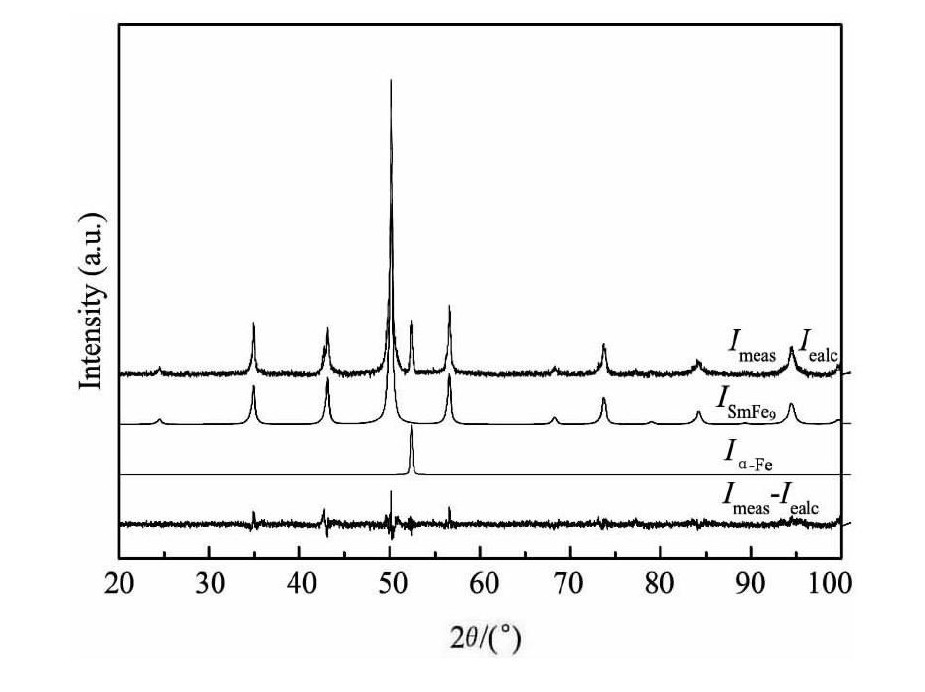
图5 Rietveld精修退火Sm Fe10.5合金的精修谱图 (其中包括Sm Fe9和α-Fe) Fig.5Rietveld analysis for Sm Fe10.5annealed at 800℃ (the set of ticks refer, respectively, to Sm Fe9, andα-Fe phases)
表6 退火后Sm Fe11合金Sm Fe9的原子占位Table 6 Atom site of Sm Fe9phase in annealed Sm Fe11alloys 下载原图

表6 退火后Sm Fe11合金Sm Fe9的原子占位Table 6 Atom site of Sm Fe9phase in annealed Sm Fe11alloys
3 结论
1.快淬Sm Fex合金在x=7.5~8.0时, 形成Th2Zn17型Sm2Fe17;在x=8.5~13.0时, 形成TbCu7型Sm Fe9。随着x不断增大, a不断减小, 而c, c/a不断增加, 原子的占位趋于无序。
2.退火Sm Fex合金在x=7.5~9.0时, 形成Th2Zn17型Sm2Fe17;在x=9.5~13.0时, 形成TbCu7型Sm Fe9。退火使原子在晶体结构中更加有序排列, 但是合金中Fe含量超过一定值以后, 不能使无序的Tb Cu7结构转化成有序的超结构。
3.退火Sm Fex合金晶胞参数变化规律与淬火相同, 但是原子排布有序化使得晶胞参数变大, 使得Sm Fex (x>9.5) 合金中α-Fe含量增加。
参考文献
[1] Ping D H, Hono K, Hidaka T, Yamaoto T, Fukuno A.Microstructural characterization ofα-Fe/Sm-Fe-N nanocomposite hard magnets[J].Journal of Magnetism and Magnetic Materials, 2004, 227 (3) :337.
[2] Mai J P, Li H W, Yu D B, Luo Y, Li K S, Wang M.Effect of HDDR process on properties of NdFeB magnetic powders[J].Chinese Journal of Rare Metals, 2011, 35 (6) :855. (麦杰平, 李红卫, 于敦波, 罗阳, 李扩社, 王民.HDDR工艺对各向同性NdFeB磁粉性能的影响[J].稀有金属, 2011, 35 (6) :855.)
[3] Coey J M D, Sun H.Improved magnetic properties by treatment of iron-based rare earth intermetallic compounds in ammonia[J].Journal of Magnetism and Magnetic Materials, 1990, 87:251.
[4] Katter M, Wecker J, Schultz L.Structural and hard magnetic properties of rapidly solidified Sm-Fe-N[J].J.Appl.Phys., 1991, 70 (6) :3188.
[5] Terrsiak A, Kubis M, Mattern N, Wolf M, Muller K H.Influence of nitrogenation on structure development and magnetic properties of mechanically alloyed and annealed Sm-Fe powders[J].Journal of Alloys and Compounds, 1999, 292 (1-2) :212.
[6] Wang X H, Liu Y, Ye J W, Zhu G L, Tu M J.Effect of Zr, Co and B elements on the structure of Sm10Fe90alloys with TbCu7-type structure[J].Material Review, 2009, 23 (10) :42. (王小红, 刘颖, 叶金文, 朱国丽, 涂铭旌.添加Zr, Co, B元素对TbCu7型Sm-Fe合金结构的影响[J].材料导报, 2009, 23 (10) :42.)
[7] Djega-Mariadassou C, Bessais L.Emergence of order in nanocrystalline SmFe9[J].Journal of Magnetism and Magnetic Materials, 2000, 210 (1-3) :81.
[8] Terrsiak A, Kubis M, Mattern N, Wolf M, Muller K H.Formation of modified TbCu7and Th2Zn17type structures during annealing of mechanical-alloyed Sm-Fe powders[J].Journal of Alloys and Compounds, 1998, 274 (1-2) :284.
[9] Schramm L, Acker J, Wetzig K.Structural effects of Zr substitution in the 1∶7-and 2∶17-type structure[J].Journal of Alloys and Compounds, 2006, 414 (1-2) :158.
[10] Nandra A, Bessais L, Djega-Mariadassou C, Burzo E.Structure and intrinsic magnetic properties of Sm (Fe, Si) 9alloy[J].Journal of Magnetism and Magnetic Materials, 2004, 272 (s) :e1243.
[11] Besais L, Dorolti E, Djega-Mariadsou C.Combined effect of gallium and carbon on the structure and magnetic properties of nanocrystalline SmFe9[J].Journal of Physics Condensed Matter, 2006, 18 (15) :3845.
[12] Kim H T, Xiao Q F, Zhang Z D, Geng D Y, Kim Y B, Kim T K, Kwon H M.Phases of melt-spun Sm1-x Fe7+x alloys and magnetic properties of their nitrides[J].Journal of Magnetism and Magnetic Materials, 1997, 173 (3) :295.
[13] Shield J E, Li C P, Branagan D J.Microstructures and phase formation in rapidly solidified Sm-Fe and Sm-FeTi-C alloys[J].Journal of Magnetism and Magnetic Materials, 1998, 188 (3) :353.
[14] Shield J E.Phase formation and crystallization behavior of melt spun Sm-Fe-based alloys[J].Journal of Alloys and Compounds, 1999, 291 (1-2) :222.
[15] Wang S X, Yu D B, Li H W, Luo Y, Li K S.Phase structure and microstructure of melt-spun SmFe alloys[J].Chinese Journal of Rare Metals, 2012, 36 (5) :721. (王士显, 于敦波, 李红卫, 罗阳, 李扩社.快淬SmFe合金相结构及显微组织研究[J].稀有金属, 2012, 36 (5) :721.)
[16] Buschow K H J, A S Van Der Goot.Domain-wall energy and coercive force of cobalt rare-earth permanent magnet materials[J].Journal of the Less Common Metals, 1971, 41 (13) :5727.
[17] Wang J, Dong J X, Zhang M C, Zheng L.Post-dynamic softening behavior of nickel-base corrosion resistant alloy G3[J].Forging&Stamping Technology, 2012, 37 (2) :143. (王珏, 董建新, 张麦仓, 郑磊.镍基耐蚀合金G3后动态再结晶行为研究[J].锻压技术, 2012, 37 (2) :143.)